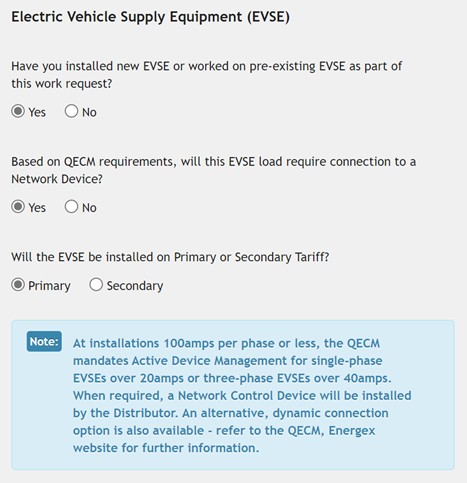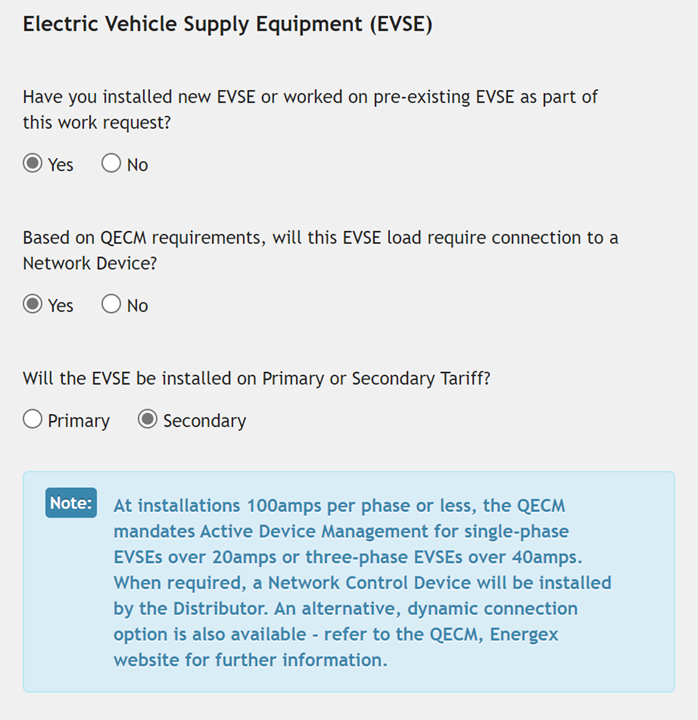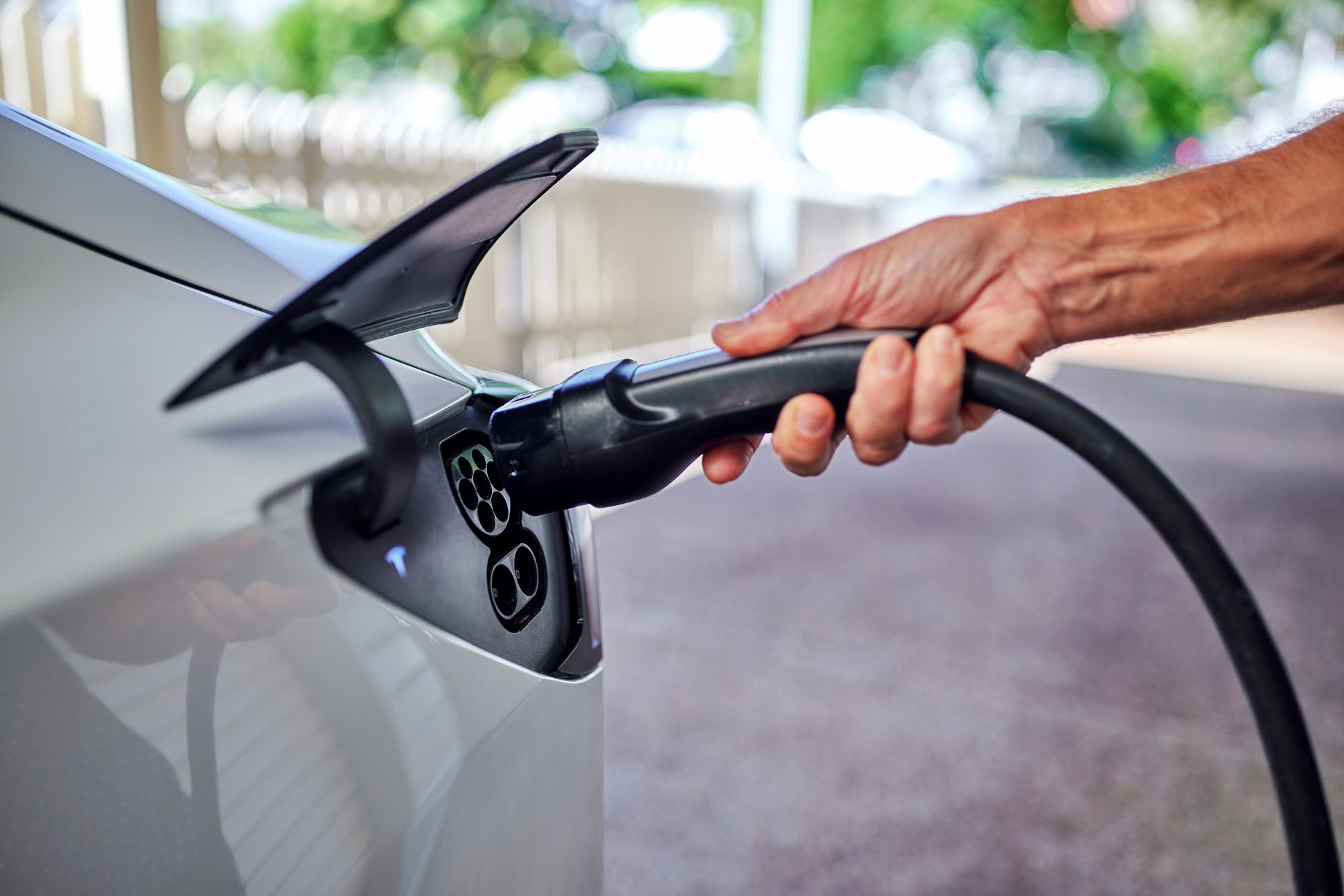EV charging & connections
We support the adoption of EVs and the ability for customers to charge them on our network, including using their own solar power. With EV battery capacity increasing, more homeowners are wanting to connect faster dedicated EV chargers, also known as Electric Vehicle Supply Equipment (EVSE).
While our network has been designed assuming that each household will use around 4 to 5kW of load on average, a dedicated EV charger typically uses around 7kW. This is a significant increase in a household’s demand on the electricity network.
New ‘managed connection’ solutions
Modelling suggests that we must manage dedicated EV chargers during peak demand times, or risk having to make costly upgrades to our network.
To help address this risk, we have two new managed connection solutions using a “network device” for dedicated EV chargers at premises supplied at 100A per phase or less.
Network devices can be operated to temporarily turn off power to the dedicated EV charger during times of peak demand on our network.
Single-phase EV charging options
Customers can charge their EV from either a 10A or 15A power point connected to a primary tariff. This enables charging from excess solar power and access to cheaper electricity rates through time-of-use tariffs or secondary load-controlled tariffs.
Customers should check with their retailer for tariff options available to them.
Above 20A equipment like dedicated EV chargers must have ‘Active Device Management’ in place. See Queensland Electricity Connection Manual (QECM) clause 8.10 & 8.14.2.2 for more information.
A typical 32A single-phase dedicated EV charger must be connected by one of the following arrangements:
- Load control tariff using a network device
- Primary tariff with basic active management via a network device (not available everywhere, see below)
- Primary tariff with a dynamic connection.
The three options are explained in more detail below.
The latter two options are new managed connection solutions allowing customers to charge their EV directly from their solar PV system, while allowing us access to manage demand on the electricity network during peak times. This will help to ensure the safety and reliability of our network.
We've also summarised these options in our fact sheet Charging your EV at home (PDF 451.3 kb). EV charger installers may find this information useful to provide to customers.
Load control tariffs have been available in Queensland for many years, and most electricity retailers offer these to customers for appliances like hot water systems, pool pumps and air conditioners. EVs can also be connected to these tariffs via a dedicated EV charger.
An economy tariff, often referred to as Tariff 33 or Controlled Load 2, would be the best load control tariff for EV charging, as it provides a minimum of 18 hours supply per day.
Some eligibility restrictions apply - for full terms and conditions including eligibility for economy tariffs, customers should talk to their electricity retailer.
How to connect
To connect a dedicated EV charger to a load control tariff, submit an Electrical Work Request (EWR) through the Electrical Partners Portal. See Queensland Electricity Connection Manual (QECM) clauses 9.2 and 10.6 for more information.
See further down this page some guidance on how to complete some of the most common EWR requests in the Portal.
This option became available from February 2024, for customers who want to connect a dedicated EV charger to a primary tariff and still use their solar power when charging their vehicle.
This option may also be attractive to customers who want to utilise time-of-use tariffs.
The technology used for this network device is the same used for our standard load control tariffs, and there is no charge from us to the customer for the installation of the network device.
The device may be operated to turn off power to the circuit supplying the dedicated EV charger. These supply interruptions are generally during the late afternoon or early evening peak period and only when the network is under stress.
Note: This connection solution is only available in areas serviced by our standard load control signalling technology. It’s not generally available in isolated communities, the Single Wire Earth Return (SWER) network, and some other fringe of grid areas. Our NMI search tool can be used to check availability.
Premises that are not serviced by our standard load control signal can select a connection option of Load Control tariff using a network device or Primary tariff with a dynamic connection to ensure compliance with the Queensland Electricity Connection Manual (QECM).
For terms and conditions for this connection option see Audio Frequency Load Control (AFLC) (PDF 372.1 kb). See also Queensland Electricity Connection Manual (QECM) clause 8.10.5 for more information.
How to connect
Connecting a dedicated EV charger (EVSE) to a network device on a primary tariff is a similar process to connecting a secondary load control tariff to a premises. You submit an EWR through the Electrical Partners Portal and select if a network device for an EVSE is required on a primary or secondary tariff.
The EWR should only be submitted when the premises is ready for the installation of the network device.
Smart meters - For sites that do not already have a smart meter (remotely read digital meter), there may be implications for meter changes where the EWR is submitted as a standalone request. Please refer to 'How to complete the EWR' below for further information.
Controlled load - The EVSE questions in the Portal are additional to the process of applying for a secondary tariff, therefore if you install EVSE on a controlled load you should also check that a valid tariff is onsite. Where this is not the case, you must also request a secondary service to install a meter for controlled load as part of your EWR.
See further down this page for how to complete some of the most common EWR requests in the Portal.
What is a dynamic connection?
Dynamic connections for dedicated EV chargers are a new form of active device management technology, where there is two-way communication between the dedicated EV charger and us.
We send signals via a gateway device to temporarily vary the capacity at which the dedicated charger can operate, depending on the demand on the electricity network. These signals are known as the dynamic operating envelope (DOE).
Installers can contact a provider from the Dynamic Connections Compliant Providers list (PDF 281.8 kb) to enquire about the current approved inverters and devices for Dynamic Connections. Look for providers with a Compliance Type “L” that have devices compatible dynamic EVSE connection. The number of providers will grow over time as more systems become certified with our utility server.
Power supply to the dedicated EV charger will only be reduced if the local network is under stress. The minimum capacity limit that will be sent by signal is 1.5kW. The maximum capacity limit sent is 15kW.
This connection allows for a dedicated charger to be installed on a primary tariff, so customers can charge their EV from their solar PV system, or take advantage of time of use tariffs. With a dynamic connection, where the output of the EVSE has been constrained, you can still use a standard power point to charge an EV (where your EV allows for this type of charging).
See Active Device Management for EVSE (PDF 314.7 kb) for more information including general advice on how often supply interruptions may occur. Also, see Queensland Electricity Connection Manual (QECM) clause 8.10.4.
Dynamic EVSE registrations
You can apply to register your EVSE with our dynamic connection server by completing our Dynamic EVSE form.
Please note:
- Only approved gateway devices will be available for selection on the Dynamic EVSE form, and as more manufacturers submit their devices to us for approval, this list will be updated
- Applications are not available in the Electrical Partners Portal and do not require a Connect Application.
Note: A premises that has an existing dynamic connection agreement for solar PV can also apply for a dynamic connection for a dedicated EV charger. As only a single set of import and export limits can be sent to a premises, a customised dynamic management solution will be developed to manage the operation of the dedicated EV charger and solar PV system.
Three-phase EV charging
At a premises wired for three-phase, a dedicated 22kW (32A per phase) three phase charger when connected and switched simultaneously across all phases, can be connected without requiring the device management options above. This will allow installation of a much faster charger.
How to submit the EWR
An Electrical Work Request (EWR) must be submitted to request the installation of the network device to connect to the EVSE.
If a Connect Agreement is required for any additional works occurring with the network device request, you must accept the Connect Agreement before it can be linked with the same EWR request.
Type of request to select
The Type of Request to select on your EWR will depend on if the work being performed is:
- standalone work, where no other work is being undertaken that would normally require an EWR, or
- additional work, where other work is occurring that would also require its own EWR.
This table will help you select the correct EWR Type of Request:
| Work scenario | EWR category | EWR action |
|---|---|---|
| Work performed as standalone request | Metering | Exchange Meter |
| Additional work also requested on the EWR | Category of the additional work type | Action of the additional work type |
How to complete the EWR
Please expand the following sections for guidance on completing these common EWRs:
1. EWR Category - select category 'Metering' and action 'Exchange Meter':

2. Electric Vehicle Supply Equipment (EVSE) - choose the following options:

3. Additional Information About Request - add a note including the number and size of the EVSE’s being added to the premises:

Complete all other required areas of the EWR.
Please Note: Since Dec 2017, new meters installed or exchanged have generally been Type 4 meters, meaning a remotely read smart meter. There are Government targets for continued deployment of smart meters, with an aim to have all suitable sites transitioned to smart metering by 2030.
This EWR request may result in the electricity retailer for the premises instigating the metering to be upgraded to a new remotely read Type 4 smart meter (if the premises is not already smart metered).
Your customers should consult with their electricity retailer to understand if any changes to their retail electricity tariff may result from the meter upgrade.
For further general information on network tariff reform visit our Residential network tariffs web page.
The following is an example of what to select for a supply upgrade combined with EVSE installation. If different works requiring an EWR are being performed, please ensure you select the most appropriate Category and Action in the Portal, as well completing the EVSE section, and making appropriate notes into the Additional Information About Request field.
1. Connect Agreement - submit the appropriate Connect Agreement and await status in the Portal of “Awaiting EWR”.
2. EWR Category - select category 'Connection / Supply' and action 'Supply Upgrade (incl install additional phases)':

3. Electric Vehicle Supply Equipment (EVSE) - choose the following options:

4. Additional Information About Request - add a note including the number and size of the EVSE’s being added to the premises:

Complete all other required areas of the EWR and link the required Connect Agreement.
Please Note: Since Dec 2017, new meters installed or exchanged have generally been Type 4 meters, meaning a remotely read smart meter. There are Government targets for continued deployment of smart meters, with an aim to have all suitable sites transitioned to smart metering by 2030.
This EWR request may result in the electricity retailer for the premises instigating the metering to be upgraded to a new remotely read Type 4 smart meter (if the premises is not already smart metered).
Your customers should consult with their electricity retailer to understand if any changes to their retail electricity tariff may result from the meter upgrade.
For further general information on network tariff reform visit our Residential network tariffs web page.
Add an EV Charger to an existing controlled load tariff as a standalone request
1. EWR Category - select category 'Metering' and action 'Add additional appliance to existing controlled load':

2. Electric Vehicle Supply Equipment (EVSE) - choose the following options:

3. Additional Information About Request - add a note including the number and size of the EVSE’s being added to the premises:

Complete all other required areas on the EWR.
Add a new controlled load tariff at the premises for an EV Charger connection
1. EWR Category - select category 'Metering' and action 'Install additional meter for hot water or controlled load':

2. Electric Vehicle Supply Equipment (EVSE) - choose the following options:

3. Additional Information About Request - add a note including the number and size of the EVSE’s being added to the premises:

Complete all other required areas on the EWR.
For more information see our frequently asked questions for EV charging connections under version 4 of the QECM.

